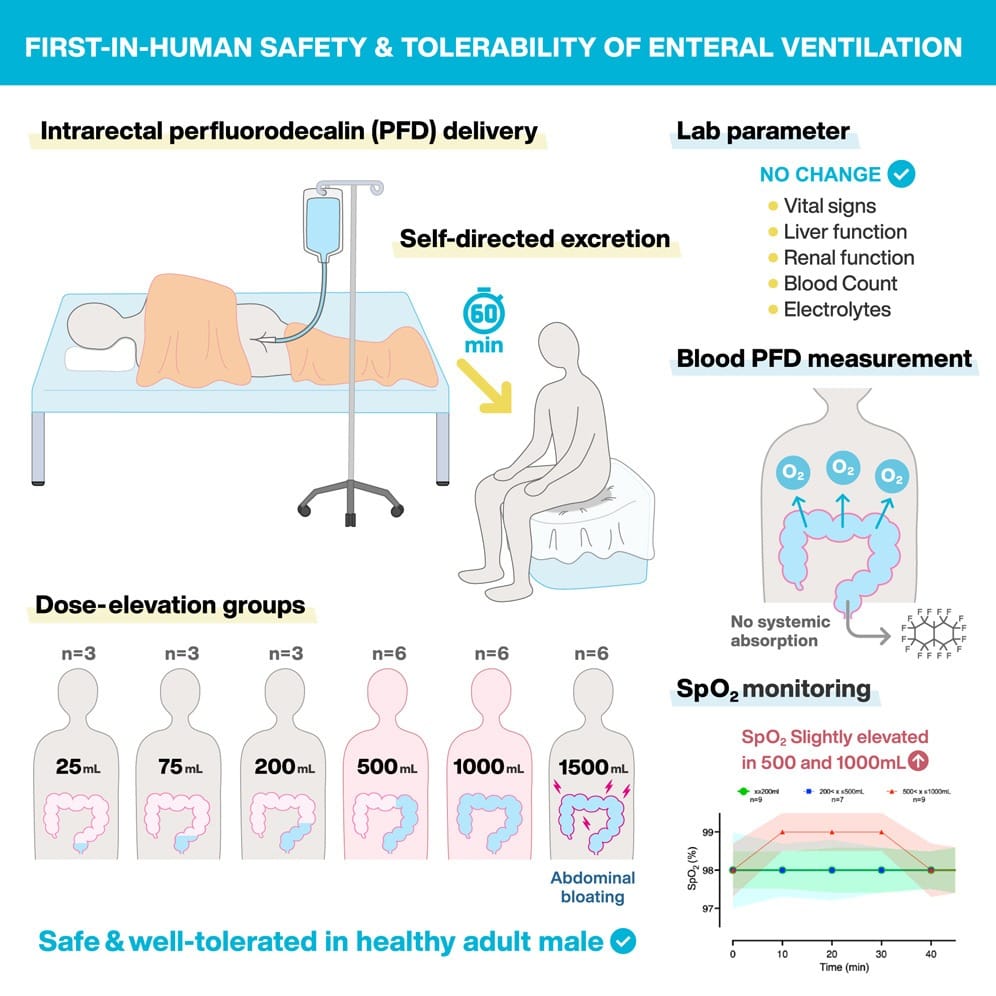🌘
Subscribe to 404 Media to get The Abstract, our newsletter about the most exciting and mind-boggling science news and studies of the week. Hold onto your butts, because one day you might be breathing through them.
Scientists have tested out enteral ventilation—a possible method of administering oxygen with a liquid delivered through the rectum that is then absorbed into the intestines—in humans for the first time. The trial demonstrated that this method of ventilation is safe and “paves the way for future studies to see if this technique can help patients with respiratory failure,” according to a study published on Monday in the journal Med.
“Enteral ventilation is not meant to replace mechanical ventilators or ECMO, but rather to serve as a complementary oxygenation route,” said Takanori Takebe, an expert in organoid medicine with appointments at both Cincinnati Children’s Hospital Medical Center and the University of Osaka, in an email to 404 Media. The technique proves a backdoor “to provide partial oxygen support while allowing the lungs to rest,” he added.
But while this method is safe for humans, it hasn’t been experimentally shown to work on patients experiencing respiratory distress yet. If future trials show that enteral ventilation is also effective, it could potentially help newborns and premature infants who are struggling to establish lung function after birth, aid patients with severe respiratory failure or Acute Respiratory Distress Syndrome (ARDS), or be applied in other situations in which temporary oxygen supplementation is needed.
“In such cases, intestinal oxygen delivery could serve as a ‘bridge’ therapy until normal respiration or full ventilatory support can be established,” Takebe said.
 A figure outlining the first enteral ventilation trial in humans. Image: Fujii, Tasuku et al.
A figure outlining the first enteral ventilation trial in humans. Image: Fujii, Tasuku et al.The team previously published a study in 2021 that showed enteral ventilation was effective in ameliorating respiratory failure in rats, mice, and pigs. This initial trial in humans involved 27 healthy male volunteers, who received a liquid called perfluorodecalin through their rectums in an enema-like process.
Since the trial was only intended to determine the safety of the procedure, rather than probe its efficacy in humans, the perfluorodecalin was not oxygenated and none of the volunteers were experiencing any respiratory distress during the course of the study.
“The results aligned closely with what we had anticipated from our preclinical data,” Takebe said. “We found that intrarectal administration of perfluorodecalin up to 1,000 mL was safe and well tolerated, with only mild and transient gastrointestinal symptoms such as bloating.”
“The next phase will involve testing ‘oxygenated’ perfluorodecalin (O₂-PFD) in patients with hypoxemia to evaluate actual oxygen transfer efficacy,” he added. “We are currently planning a Phase II trial in collaboration with clinical partners in Japan and the U.S.”
Takebe and his colleagues were inspired to develop this roundabout route by aquatic species, such as loaches, which absorb oxygen through their intestines to survive in low-oxygen environments. While the idea of rectally administering perfluorodecalin is relatively new, the use of oxygenated liquid for ventilation dates back decades. It even shows up in James Cameron’s 1989 thriller The Abyss, which includes a real scene of a rat breathing in a tank of liquid perfluorocarbon.
The technique may prove to be an effective means to alleviate respiratory distress in humans, but it’s also inspired its fair share of jokes because, well, it is about butt breath, after all.
In 2024, for instance, Takebe’s team received the Ig Nobel Prize, a satirical award that honors “achievements so surprising that they make people laugh, then think,” according to its website. Fellow Ig Nobel awardees include a team that levitated a frog in midair and another that investigated why pregnant women aren’t constantly tipping over.
“Receiving the Ig Nobel Prize was both humorous and humbling,” Takebe said. “It was a reminder that truly unconventional ideas often begin at the boundary between curiosity and skepticism.”
“While the prize is lighthearted in tone, I do believe it serves a serious purpose, encouraging the public to stay curious and to appreciate how even seemingly odd scientific questions can lead to meaningful innovations,” he concluded. “What began as a playful concept is now moving closer to a viable medical technology.”
🌘
Subscribe to 404 Media to get The Abstract, our newsletter about the most exciting and mind-boggling science news and studies of the week.
 undefined Maronno Winchester :antifa: shared this topic
undefined Maronno Winchester :antifa: shared this topic

 A figure outlining the first enteral ventilation trial in humans. Image:
A figure outlining the first enteral ventilation trial in humans. Image:

